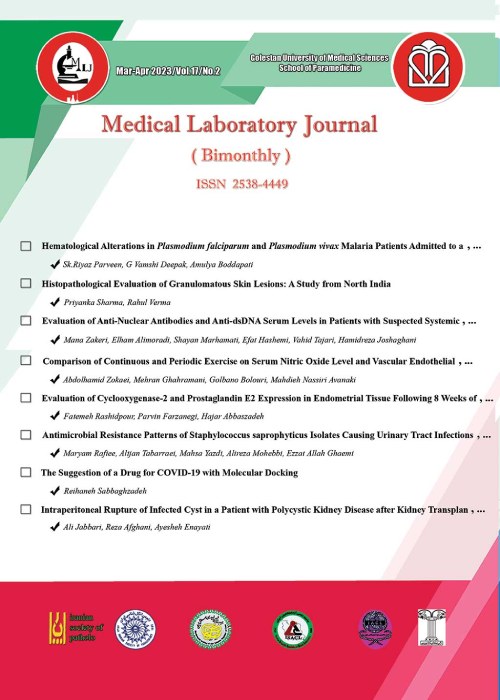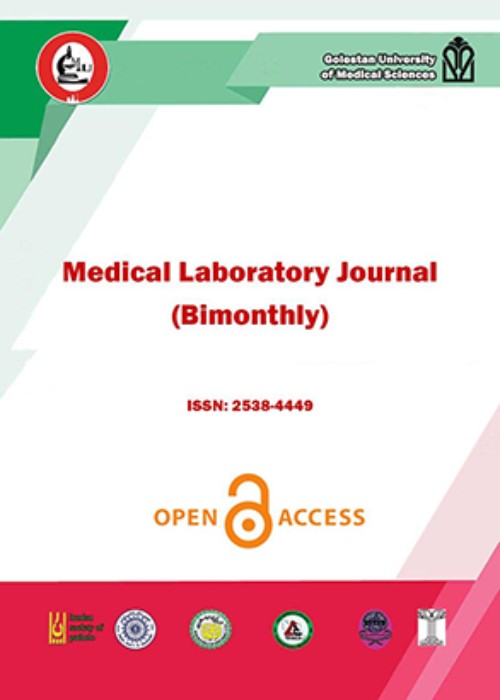فهرست مطالب

Medical Laboratory Journal
Volume:17 Issue: 2, Mar-Apr 2023
- تاریخ انتشار: 1401/12/10
- تعداد عناوین: 8
-
-
Pages 1-6Background and objectives
Malaria causes a wide spectrum of hematological and clinical manifestations. This study aimed to identify the alterations in the clinical and hematological parameters in patients infected with Plasmodium vivax, Plasmodium falciparum, and mixed species.
MethodsThe study included 126 smear-positive malaria cases, and various hematological parameters were studied.
ResultsThe frequency of P. vivax, P. falciparum, and mixed species was 53.9%, 36.5%, and 9.6%, respectively. Anemia (hemoglobin <11 gm%) was seen in 79.3% of the cases, and severe anemia (hemoglobin <5g%) was detected in 27.7% of the cases. A decrease in red blood cell count was observed in 67% of P. falciparum and 47% cases of P. vivax cases. Increased red cell distribution width and erythrocyte sedimentation rate were seen in 81% and 78% of the cases, respectively. Leukocytosis and leucopenia were detected in 15% and 16% of all malaria cases, respectively. Thrombocytopenia was associated with 78% of cases infected with P. vivax. The degree of anemia was correlated with the parasite load, and the degree of parasitemia was correlated with the extent of thrombocytopenia. There were also significant variations in the mean corpuscular volume, hematocrit, mean corpuscular hemoglobin concentration, and platelet counts among malarial species (p<0.05).
ConclusionMalaria is frequently associated with anemia, thrombocytopenia, and leukopenia. Thrombocytopenia is mostly associated with P. vivax infection. On contrary, leukopenia is more prevalent in P. falciparum, followed by P. vivax and mixed parasitemia.
Keywords: Leukopenia, Malaria, Plasmodium falciparum, Plasmodium vivax -
Pages 7-13Background and objectives
Granulomatous disorders of the skin are frequently encountered in clinical practice and require histopathological confirmation due to a considerable etiological and clinical overlap. A single histopathological pattern may be produced by many causative agents and at the same time, a single cause can present with varied histopathological patterns. The present study was performed to evaluate the histomorphological patterns of granulomas in various granulomatous skin lesions and to identify the causative agents.
MethodsThe study (both prospective and retrospective) was carried out in the department of pathology over 5 years. All skin biopsies were evaluated for the presence of granulomas. Detailed analysis of the histopathological pattern of granulomas was performed and categorization was made according to the type and etiology. Special stains were also used when required. A clinicopathological correlation was established with the Kappa statistic.
ResultsOf 1,150 skin biopsies, granulomatous skin lesions were observed in 325 cases. Histiocytic granuloma pattern was the most common subtype (55.7%). The predominant etiology of granulomatous inflammation was leprosy (93.5%), followed by cutaneous tuberculosis (2.7%). The cases of Hansen’s disease showed a maximum clinicopathological correlation (58.5%).
ConclusionHistopathological examination is the gold standard for the diagnosis and subtyping of granulomatous skin lesions. Varied morphologies of granuloma patterns were observed in our study, and infectious diseases were the causative agents in the majority of cutaneous granulomatous disorders.
Keywords: Granuloma, Leprosy, Tuberculosis -
Pages 14-19Background and objectives
Systemic lupus erythematosus (SLE) is a chronic autoimmune disease, caused by abnormal innate and adaptive immune responses. Anti-nuclear antibodies (ANA) and anti-double stranded DNA (anti-dsDNA) are reliable biomarkers for diagnosing SLE. Here, we aimed to investigate the serum levels of anti-dsDNA and ANA antibodies, their diagnostic utilities, and their relationship with disease activity and clinical/laboratory manifestations in patients with suspected.
MethodsWe evaluated the plasma levels of ANA and anti-dsDNA antibodies in all individuals with suspected SLE (n=668) who had been referred to rheumatology clinics in Gorgan, Iran. The level of antibodies as well as C3, C4, and CH50 were determined using commercially available enzyme-linked immunosorbent assay kits.
ResultsThe mean level of ANA and anti-dsDNA antibodies differed significantly between the ANA-positive and ANA-negative groups (p<0.001). However, there was no significant difference in the mean values of C3 (p=0.233), C4 (p=0.415, and CH50 (p=0.482) between the two groups. Moreover, there was a significant positive correlation between ANA and anti-dsDNA levels (p<0.001, r=0.50).
ConclusionOur findings indicate that anti-dsDNA levels are higher in ANA-positive individuals, and there may be a positive correlation between ANA and anti-dsDNA levels. It is recommended to evaluate the diagnostic and prognostic values of ANA and anti-dsDNA antibodies in future studies.
Keywords: Antibodies, Antinuclear, Lupus Erythematosus, Systemic, ELISA, Diagnosis -
Pages 20-25Background and objectives
Considering the importance of aging and the associated physiological changes, as well as the effects of exercise on angiogenesis and cardiac index, this study aimed to compare continuous and periodic exercise in form of high-intensity interval training (HIIT) on serum levels of nitric oxide (NO) and vascular endothelial growth factor (VEGF) in old rats.
MethodsIn this study, 30 old male rats were randomly divided into three groups: continuous training (n=10), HIIT (n=10), and control group (n=10). Interventions were performed for 8 weeks. To evaluate the research variables, 72 hours before the first training session and after the last training session, 3 ml of blood were taken from the tails of the rats. One-way analysis of variance was used to analyze the findings and Levene's test was used for assessing the homogeneity of variance. All statistical tests were performed using SPSS 17 software at a significance level of 0.05.
ResultsBoth training exercises significantly increased NO and VEGF levels compared to the control group (p<0.05).
ConclusionThe results of this study showed that 8 weeks of continuous and interval training cause a significant increase in the level of angiogenic factors in old rats. Therefore, these exercises and especially alternative exercises can be used as a suitable way to increase angiogenesis in the elderly.
Keywords: Exercise, Vascular Endothelial Growth Factors, Nitric Oxide -
Pages 26-32Background and objectives
Endometriosis is a chronic disease that affects approximately 10% of women of reproductive age. The purpose of this study was to evaluate the effects of 8 weeks of swimming exercise and omega-3 supplementation on the expression of cyclooxygenase-2 (COX-2) and prostaglandin E2 (PGE2) genes and serum levels of reproductive hormones in the endometrial tissue of a rat model of endometriosis.
MethodsIn this experimental study, 30 adult Wistar rats were randomly divided into 5 groups of healthy-control, patient-control, patient+exercise, patient+omega-3, and patient+omega-3+exercise groups. After the induction of endometriosis, the rats were subjected to 8 weeks of swimming exercise, 5 days a week as well as 2 ml/kg/body weight of omega-3. Data were analyzed using one-way analysis of variance and Tukey post hoc test at the significance level of 0.05.
ResultsThe expression of COX-2 and PGE2 as well as serum follicle-stimulating hormone (FSH), luteinizing hormone (LH), and estradiol levels were significantly higher in the patient group compared with the healthy-control group (p≤0.0001). Exercise and omega-3 supplementation either separately or combined could significantly reduce the expression of both genes and serum levels of LH, FSH, and estradiol (p<0.05). This effect was more profound in the patient+exercise+omega-3 group.
ConclusionThe results of the present study indicate that regulating the expression of COX-2 and PGE2 genes as well as serum levels of reproductive hormones through swimming exercise and omega-3 supplementation can improve endometriosis.
Keywords: Cyclooxygenase-2, Prostaglandin E2, Endometriosis, Exercise -
Pages 33-38Background and objectives
Urinary tract infection (UTI) is one of the most common bacterial infections. Staphylococcus saprophyticus is a common Gram-positive bacterium that causes uncomplicated UTIs in women. The present study aimed to study the drug resistance pattern and phenotypic and genotypic variation of S. saprophyticus isolates from women with UTI in Gorgan, northern Iran.
MethodsThis study was performed from May 2018 to September 2020. During this time, 35 S. saprophyticus strains were isolated from patients with UTI. The antimicrobial patterns of the isolates were determined by a conventional method. Phenotypic criteria such as pigment production, mannitol fermentation, urease production, and 16SrRNA gene valuation were studied.
ResultsAll isolates were sensitive to nitrofurantoin, gentamicin, and linezolid. S. saprophyticus isolates showed the highest level of resistance to penicillin (85.7%) and erythromycin (51.4%). A variation was detected among S. saprophyticus isolates in terms of pigment production i.e. about 51.4% showed yellow pigment in Muller Hinton agar, and 62.9% of the isolates were able to ferment mannitol sugar. Of 11 isolates that were sequenced for the 16SrRNA gene, only two isolates showed different patterns.
ConclusionNitrofurantoin and trimethoprim-sulfamethoxazole are the antibiotics of choice for the treatment of UTI caused by S. saprophyticus in the study area. Due to the phenotypic and genotypic differences among S. saprophyticus isolates, typing of S. saprophyticus at the subspecies level is recommended.
Keywords: Staphylococcus saprophyticus, Urinary tract infection, Drug Resistance, Microbial -
Pages 39-44Background and objectives
This study aimed to study the interaction between the severe acute respiratory syndrome coronavirus 2 (SARS‑CoV‑2) spike protein complex and seven drugs that inhibit the angiotensin-converting enzyme 2.
MethodsPlots of protein-ligand interaction were obtained using the LigPlot software. In addition, binding energies in kcal/mol, hydrophobic interactions, and hydrogen bonds were determined. Autodock software v.1.5.6 and AutoDock Vina were used for the analysis of molecular docking processes.
ResultsThe only structure that interacted with the SARS‑CoV‑2 spike protein was anakinra.
ConclusionAnakinra was the only drug that interacted with the SARS‑CoV‑2 spike protein. This could be further investigated for finding a temporary alternative medicine for the treatment of coronavirus disease 2019.
Keywords: Molecular Docking Simulation, SARS-CoV-2, Software -
Pages 45-48Background
Autosomal dominant polycystic kidney disease (ADPKD) is a multisystem disorder characterized by progressive renal cysts formation and extra-renal manifestations. Infection within the cysts and abscess formation are rare but life threatening if left untreated. We present a rare case of peritonitis presentation due to intraperitoneal rupture of an infected cyst in a woman with polycystic kidney disease.
Case descriptionA 42-year-old woman presented with constant progressing abdominal pain and vomiting. She complained of abdominal distention, bloating, and a change in bowel habits from two days ago. On physical examination, bilateral enlarged masses of flanks, generalized tenderness, and distention of the abdomen were found. The patient received conventional therapy. After appropriate fluid and electrolyte management and rescue care, appropriate antibiotics were prescribed, and laparotomy was performed. The rupture of an infected cyst of the right polycystic kidney into the peritoneal cavity was the cause of peritonitis in this patient. She successfully underwent a right radical nephrectomy (32×21cm, and 3,300 gr). The postoperative period was uneventful and the patient was discharged from the hospital after a week.
ConclusionAntibiotic therapy is the first step in the treatment of renal cyst infection. When primary antibiotic therapy fails, drainage of the infected cyst is recommended. In medically fit patients for surgery and patients who present with complications of the infected cyst, radical surgery and nephrectomy is the procedure of choice. The best outcome is achieved after nephrectomy.
Keywords: Peritonitis, Polycystic kidney disease, Kidney Transplantation


